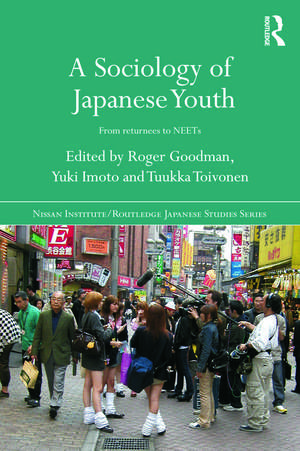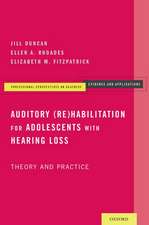A Sociology of Japanese Youth: From Returnees to NEETs
Editat de Roger Goodman, Yuki Imoto, Tuukka Toivonenen Limba Engleză Paperback – 28 noi 2011
The chapters include case studies covering issues such as:
Returnee children (kikokushijo)
Compensated dating (enjo kōsai)
Corporal punishment (taibatsu)
Bullying (ijime)
Child abuse (jidō gyakutai)
The withdrawn youth (hikikomori) and
NEETs (not in education, employment or training)
By examining these various social problems collectively, A Sociology of Japanese Youth explains why particular youth problems appeared when they did and what lessons they can provide for the study of youth problems in other societies.
This book will be of huge interest to students and scholars of Japanese society and culture, the sociology of Japan, Japanese anthropology and the comparative sociology of youth studies.
| Toate formatele și edițiile | Preț | Express |
|---|---|---|
| Paperback (1) | 431.35 lei 43-57 zile | |
| Taylor & Francis – 28 noi 2011 | 431.35 lei 43-57 zile | |
| Hardback (1) | 1219.06 lei 43-57 zile | |
| Taylor & Francis – 28 noi 2011 | 1219.06 lei 43-57 zile |
Preț: 431.35 lei
Nou
Puncte Express: 647
Preț estimativ în valută:
82.56€ • 89.71$ • 69.40£
82.56€ • 89.71$ • 69.40£
Carte tipărită la comandă
Livrare economică 21 aprilie-05 mai
Preluare comenzi: 021 569.72.76
Specificații
ISBN-13: 9780415669276
ISBN-10: 0415669278
Pagini: 216
Ilustrații: 12 black & white tables, 9 black & white halftones, 21 black & white line drawings
Dimensiuni: 156 x 234 x 15 mm
Greutate: 0.34 kg
Ediția:1
Editura: Taylor & Francis
Colecția Routledge
Locul publicării:Oxford, United Kingdom
ISBN-10: 0415669278
Pagini: 216
Ilustrații: 12 black & white tables, 9 black & white halftones, 21 black & white line drawings
Dimensiuni: 156 x 234 x 15 mm
Greutate: 0.34 kg
Ediția:1
Editura: Taylor & Francis
Colecția Routledge
Locul publicării:Oxford, United Kingdom
Public țintă
Postgraduate and UndergraduateCuprins
1. Making Sense of Youth Problems, Tuukka Toivonen and Yuki Imoto 2. From Pitiful to Privileged? The Fifty Year Story of the Changing Perception and Status of Japan’s Returnee Children (kikokushijo), Roger Goodman 3. Narratives and Statistics: How Compensated Dating (enjo kōsai) Was Sold, Sharon Kinsella 4. Taibatsu: From Educational Solution to Social Problem to Marginalized Non-Issue, Aaron Miller 5. The ‘Discovery’ and ‘Rediscovery’ of Child Abuse (jidō gyakutai) in Japan, Roger Goodman 6. Hikikomori: How Private Isolation Caught the Public Eye, Sachiko Horiguchi 7. NEETs: The Strategy within the Category, Tuukka Toivonen 8. Shifting Landscapes: The Social Context of Youth Problems in an Ageing Nation, Roger Goodman
Notă biografică
Roger Goodman is Nissan Professor of Modern Japanese Studies and Head of the Social Science Division at the University of Oxford, UK.
Yuki Imoto is a Research Associate at Keio University, Japan.
Tuukka Toivonen is a Junior Research Fellow at Green Templeton College, University of Oxford, UK.
Yuki Imoto is a Research Associate at Keio University, Japan.
Tuukka Toivonen is a Junior Research Fellow at Green Templeton College, University of Oxford, UK.
Recenzii
"This superb collection of essays presents a social constructionist analysis of why youth problems erupt when they do and how they evolve. This is an exceptionally well-written book that is destined to become a classic in Japanese studies and is a truly collaborative effort that benefits from a high degree of dialogue between the authors." - Jeff Kingston, Temple University Japan; The Japan Times, Sunday, May 20, 2012
"The approach adopted in this book is unique... A characteristic of this book that has not been seen in others is that it delves into the public discourse that explains youg people." - Yuji Genda, University of Tokyo; Journal of Japanese Studies 39.1, 2013.
"The approach adopted in this book is unique... A characteristic of this book that has not been seen in others is that it delves into the public discourse that explains youg people." - Yuji Genda, University of Tokyo; Journal of Japanese Studies 39.1, 2013.
Descriere
This book puts forth a sociology of Japanese youth problems showing that the Japanese media draw on an equally, if not more, perplexing gallery of social categories when it discusses youth than affluent Western societies such as the US or UK and that Japan is no less replete with social problems involving young people and no less capable of generating hysteria over the fate of its youth than affluent Western societies such as the US or UK.






















